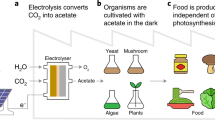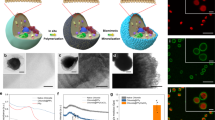Abstract
Hydrogen can be produced by illumination of an aqueous mixture of chloroplasts and hydrogenase, in the presence of an electron carrier1,2. This system may have potential for development of a solar converter to produce hydrogen from water3,4 if it can be stabilized or constructed as a completely synthetic system. The immobilization of the chloroplasts, or membrane analogues, would make possible a one-stage reactor with all the components in one chamber, or a two-stage reactor if the electron carrier was passed to another chamber to react with an immobilized hydrogen-producing catalyst. However, techniques for immobilizing enzymes tend to yield immobilized chloroplasts that are not very active, and other methods must be used5–8 . We describe here the immobilization of chloroplasts using calcium alginate gels on reinforcing grids of nylon and stainless steel. Chloroplasts thus immobilized are fully active and can be used to produce hydrogen gas. Strengthened films of this sort could provide a good, solid, rigid matrix for a solar converter.
This is a preview of subscription content, access via your institution
Access options
Subscribe to this journal
Receive 51 print issues and online access
$199.00 per year
only $3.90 per issue
Buy this article
- Purchase on Springer Link
- Instant access to full article PDF
Prices may be subject to local taxes which are calculated during checkout
Similar content being viewed by others
References
Rao, K. K. & Hall, D. O. Photosynthesis in Relation to Model Systems (ed. Barber, J.) 299–329 (Elsevier, Amsterdam, 1979).
Weaver, P. F., Lien, S. & Seibert, M. Solar Energy 24, 3–45 (1980).
Porter, G. & Archer, M. D. Interdisc. Sci. Rev. 1, 119–143 (1976).
Bolton, J. & Hall, D. O. A. Rev. Energy 4, 353–401 (1979).
Keirstan, M. & Bucke, C. Biotech. Bioengng 19, 387–397 (1977).
Ochiai, H., Shibita, H., Fujishima, A. & Honda, K. Agric. biol. Chem. 43, 881–883 (1979).
Cocquempot, M. D., Thomas, D., Champigny, M. L. & Moyse, A. Eur. J. appl. Microbiol. Biotech. 8, 37–42 (1979).
Rao, K. K. et al. Proc. int. Symp. Biological Applications of Solar Energy (eds Gnanam, A., Krishnaswamy, S. & Kahn, J. S.) 199–204 (Macmillan, India, 1980).
Cheetham, P. S. J., Blunt, K. W. & Bucke, C. Biotech. Bioengng 21, 2155–2168 (1979).
Kiwi, J. & Gratzel, M. Am. chem. Soc. J. 101–24, 7214–7217 (1979).
Ochiai, H., Shibata, H., Sawa, Y. & Katoh, T. Proc. natn. Acad. Sci. U.S.A. 77, 2442–2444 (1980).
Kaneko, M., Motoyoshi, J. & Yamada, A. Nature 285, 468–470 (1980).
Lilley, R. McC. & Walker, D. A. Biochim. biophys. Acta 368, 269–278 (1974).
Reeves, S. G. & Hall, D. O. Biochim. biophys. Acta 314, 66–78 (1973).
Hall, D. O. Nature new Biol. 235, 125–126 (1972).
Rao, K. K., Rosa, L. & Hall, D. O. Biochem. biophys. Res. Comm 68, 21–27 (1976).
Author information
Authors and Affiliations
Rights and permissions
About this article
Cite this article
Gisby, P., Hall, D. Biophotolytic H2 production using alginate-immobilized chloroplasts, enzymes and synthetic catalysts. Nature 287, 251–253 (1980). https://doi.org/10.1038/287251a0
Received:
Accepted:
Issue Date:
DOI: https://doi.org/10.1038/287251a0
This article is cited by
-
Combined local immunostimulatory radioisotope therapy and systemic immune checkpoint blockade imparts potent antitumour responses
Nature Biomedical Engineering (2018)
-
High-Alkaline protease fromBacillus PB92 entrapped in calcium alginate gel
Applied Biochemistry and Biotechnology (1995)
-
Immobilization of a photosystem ii submembrane fraction in a glutaraldehyde cross-linked matrix
Applied Biochemistry and Biotechnology (1987)
-
The effects of high concentrations of salts on photosynthetic electron transport of immobilized thylakoids: Functional stability
Applied Microbiology and Biotechnology (1984)
-
Photoproduction of H2 and NADPH2 by polyurethane-immobilized cyanobacteria
Biotechnology Letters (1983)
Comments
By submitting a comment you agree to abide by our Terms and Community Guidelines. If you find something abusive or that does not comply with our terms or guidelines please flag it as inappropriate.



